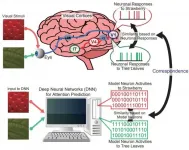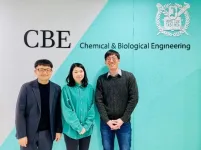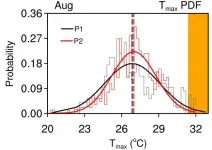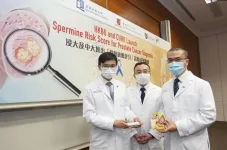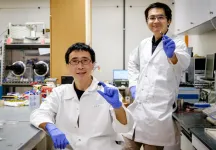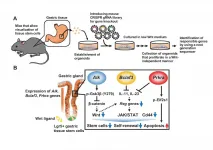Joint radionuclide therapy-immunotherapy approach effective in prostate cancer model
2021-02-08
(Press-News.org) Reston, VA--A combination of radionuclide therapy and immunotherapy has proven successful in slowing the progression of prostate cancer and increasing survival time, according to new research published in the February issue of The Journal of Nuclear Medicine. The results of the murine study indicate that radionuclide therapy promotes prostate cancer immunogenicity, provoking a cellular response that makes the tumors more receptive to immunotherapy.
"Prostate cancer is generally viewed as an immunological cold cancer in which immunotherapies only have moderate success," said Katharina Lückerath, PhD, assistant professor of preclinical theranostics at the University of California Los Angeles in California. "Increasing prostate cancer immunogenicity with prostate-specific membrane antigen (PSMA) radionuclide therapy, however, might render immunotherapies more successful. In our research we sought to exploit this effect by combining radionuclide therapy with immunotherapy in a mouse model of prostate cancer."
In the study, mice bearing prostate cancer tumors received one of four treatments: an isotope control antibody, 225Ac-PSMA617 radionuclide therapy, an anti-PD-1 antibody or both 225Ac-PSMA617 radionuclide therapy and an anti-PD-1 antibody. Therapeutic efficacy was assessed by measuring tumor volume (with computed tomography), time to progression and survival.
While 225Ac-PSMA617 radionuclide therapy and PD-1 blockade alone tended to prolong time to progression as compared to the isotope control (30 days and 33.5 days, respectively, versus 25 days), combining 225Ac-PSMA617 radionuclide therapy and PD-1 blockade significantly improved time to progression (47.5 days). Survival time also increased greatly for the joint therapeutic approach (51.5 days) when compared to225Ac-PSMA617 radionuclide therapy (32 days), anti-PD-1 (37 days) and the control (28 days).
"These findings suggest that radionuclide therapy may have a profound impact on the tumor immune microenvironment that can facilitate immunotherapies in prostate cancer," noted Lückerath. "Radionuclide therapy and immunotherapy combinations are promising therapeutic options for prostate cancer patients, and the data reported in our study support the clinical translation of radionuclide therapy-immunotherapy combination regimens."
In addition to this study, recently launched clinical trials for prostate cancer treatment and new tracers developed to image immune responses underscore the high interest in exploring immunity using molecular imaging and in combining radionuclide therapy with immunotherapy. According to Lückerath, these initiatives might expand the scope of nuclear medicine to immunology and strengthen nuclear medicine's ability to offer powerful and versatile treatment options.
INFORMATION:
This study was made available online in July 2020 ahead of final publication in print in February 2021.
The authors of "Immune-Checkpoint Blockade Enhances 225Ac-PSMA617 Efficacy in a Mouse Model of Prostate Cancer" include Johannes Czernin, Kyle Current, Christine E. Mona, Lea Nyiranshuti, Firas Hikmat, Caius G. Radu and Katharina Lückerath, Department of Molecular and Medical Pharmacology, David Geffen School of Medicine, UCLA, Los Angeles, California.
This study was partially funded by the Prostate Cancer Foundation (19CHAL09). Johannes Czernin and Caius Radu are cofounders and hold equity in Sofie Biosciences, Trethera Therapeutics. Intellectual property has been patented by UCLA and licensed to Sofie Biosciences, Trethera Therapeutics, but was not used in the current study.
Please visit the SNMMI Media Center for more information about molecular imaging and precision imaging. To schedule an interview with the researchers, please contact Rebecca Maxey at (703) 652-6772 or rmaxey@snmmi.org.
About the Society of Nuclear Medicine and Molecular Imaging
The Journal of Nuclear Medicine (JNM) is the world's leading nuclear medicine, molecular imaging and theranostics journal, accessed close to 10 million times each year by practitioners around the globe, providing them with the information they need to advance this rapidly expanding field. Current and past issues of The Journal of Nuclear Medicine can be found online at http://jnm.snmjournals.org.
JNM is published by the Society of Nuclear Medicine and Molecular Imaging (SNMMI), an international scientific and medical organization dedicated to advancing nuclear medicine and molecular imaging--precision medicine that allows diagnosis and treatment to be tailored to individual patients in order to achieve the best possible outcomes. For more information, visit http://www.snmmi.org.
[Attachments] See images for this press release:
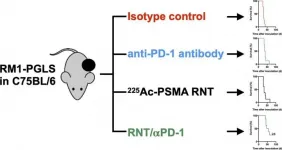
ELSE PRESS RELEASES FROM THIS DATE:
2021-02-08
Geoscientists have released a video that for the first time shows the uninterrupted movement of the Earth's tectonic plates over the past billion years.
The international effort provides a scientific framework for understanding planetary habitability and for finding critical metal resources needed for a low-carbon future.
It reveals a planet in constant movement as land masses move around the Earth's surface, for instance showing that Antarctica was once at the equator.
The video is based on new research published in the March 2021 edition of ...
2021-02-08
This discovery was made possible by applying the research method for the comparison of the brain activity between monkeys and humans to artificial neural networks. This finding might be helpful not only to understand the cortical mechanism of attentional selection but also to develop artificial intelligence.
Deep neural networks (DNNs), which are used in the development of artificial intelligence, are mathematical models for obtaining appropriate mechanisms to solve specific problems from the training with a large-scale dataset. However, the detailed mechanisms underlying DNNs through ...
2021-02-08
On Feb 5th, Seoul National University, College of Engineering (Dean Kookheon Char) announced that Professor Sang Woo Seo's research team (Dr. Jina Yang and Mr. Yong Hee Han (graduate student)) at School of Chemical and Biological Engineering has developed a synthetic protein quality control system to enhance full-length translation in bacteria. This technology is expected to increase the efficiency of the production of biopharmaceuticals, industrial enzymes, and bio-based chemicals.
Recombinant proteins are used in various industrial fields from protein drugs such as insulin to industrial proteins such as laundry detergents. Since proteins can perform their functions only with full-length and proper 3D structure, recombinant protein production ...
2021-02-08
Against the background of global warming, extreme heat days (EHDs) occur frequently and greatly threaten human health and societal development. Therefore, it is of great importance to understand the variation of EHDs.
Previous studies have indicated that the frequency of EHDs is mainly modulated by the mean state of temperature, and thus the frequency of EHDs mostly presents an increasing trend.
"However, the variability of the daily maximum temperature also plays an important role in the interdecadal change of extreme heat days over Northeast China," says Ms. Liu Wenjun, a Master's student from the group of Dr. Ruidan Chen in the School of Atmospheric Sciences ...
2021-02-08
Researchers from Hong Kong Baptist University (HKBU) and the Faculty of Medicine at The Chinese University of Hong Kong (CU Medicine) have jointly developed the Spermine Risk Score which, coupled with the use of a urine test, provides a non-invasive and more reliable method for the diagnosis of prostate cancer. In a study conducted by the researchers, about 37% of the patients, who were ultimately found to have no prostate cancer, can avoid undergoing a prostate biopsy procedure. The findings have just been published in the scientific journal Prostate Cancer and Prostatic Diseases.
Demand for more reliable and non-invasive diagnosis
Prostate cancer is the third most common and the fourth most fatal cancer for the male ...
2021-02-08
Which bananas end up in your shopping basket-- the uniformly yellow ones or those with brown spots?
If you are like most people, you skip the spotted ones and select those that are perfectly yellow. This is because emotions play an an oversized role in our shopping decisions, according to a new study by Danish and Swedish researchers.
"We choose food based upon an expectation of what it will taste like that is bound to our feelings. So, if we expect a brown banana to not match the taste of a yellow one, we opt for the latter," explains Karin Wendin, an associate professor at University of Copenhagen's Department of Food Science, and one of the researchers behind the study.
Approximately 716,000 tonnes ...
2021-02-08
A team of researchers led by Nanyang Technological University, Singapore (NTU Singapore) has developed a new material, that when electricity is applied to it, can flex and bend forty times more than its competitors, opening the way to better micro machines.
Conversely, when it is bent, it generates electricity very effectively and could be used for better "energy harvesting" - potentially recharging batteries in gadgets just from everyday movements.
The novel material is both electrostrictive and piezoelectric. Its electrostrictive properties means it can change shape when an electric current is applied, while piezoelectric means the material can convert pressure into electric charges.
When an electric field is applied, the atoms that make up electrostrictive ...
2021-02-08
Although SGLT-2 inhibitors are central to the treatment of diabetes, their exact mode of action was hitherto unknown. In a study conducted by a research group led by Peter Wolf, Martin Krssak and Michael Krebs from MedUni Vienna's Department of Medicine III, magnetic resonance spectroscopy (MRS) was used to show that there is a direct correlation between the elimination of glucose via the kidneys and new glucose production in the liver. A single dose of the SGLT-2 inhibitor dapagliflozin gives rise to a beneficial regulation mechanism, in which glucose loss due to drug-induced SGLT-2 inhibition is exactly balanced out by an equal increase in new glucose production in the liver. The study has been published in the leading journal Diabetes Care.
Dapagliflozin is a drug from the group ...
2021-02-08
Researchers at the Kobe University Graduate School of Science have revealed that when captive-bred juvenile red-spotted masu salmon are released into natural streams, very few individuals become migrants.
Red-spotted masu salmon was an important fish species for the fishing industry in the rivers of west Japan, however in recent years their numbers are declining rapidly. The results of this research offer important suggestions for stocking practices and the management of river environments.
The research group consisted of graduate school students TANAKA Tatsuya and UEDA Rui and Associate Professor SATO Takuya. The results were published in Biology Letters ...
2021-02-08
[Background]
The human body consists of about 60 trillion cells that are renewed day by day to maintain homeostasis of body tissues. In particular, cells of the digestive tract are renewed completely within several weeks thanks to vigorous proliferation where tissue stem cells of every tissue play critical roles in supplying those cells. Tissue stem cells play essential roles in various phenomena such as histogenesis and recovery from damage by producing differentiated cells while dividing. They do this by producing identical cells (self-renewal) or by differentiating into other types of cells. The research team led by Profs. Murakami and Barker of the Cancer Research Institute, Kanazawa University revealed ...
LAST 30 PRESS RELEASES:
[Press-News.org] Joint radionuclide therapy-immunotherapy approach effective in prostate cancer model

